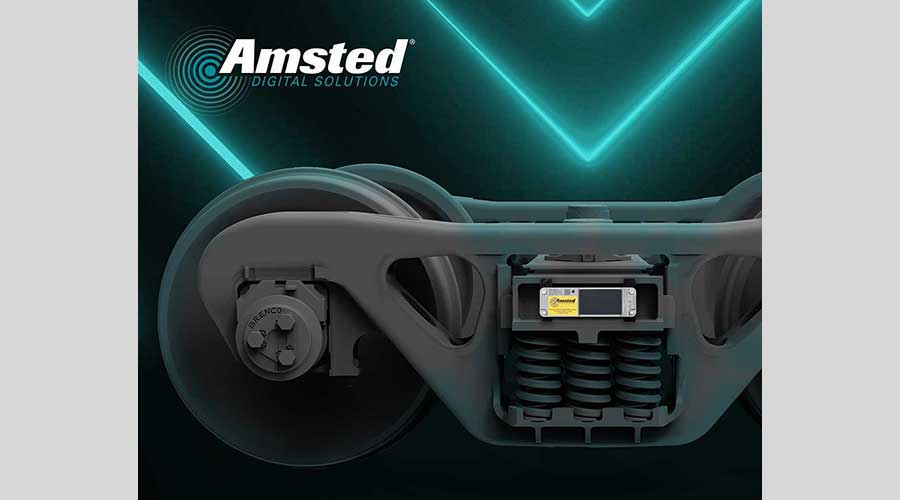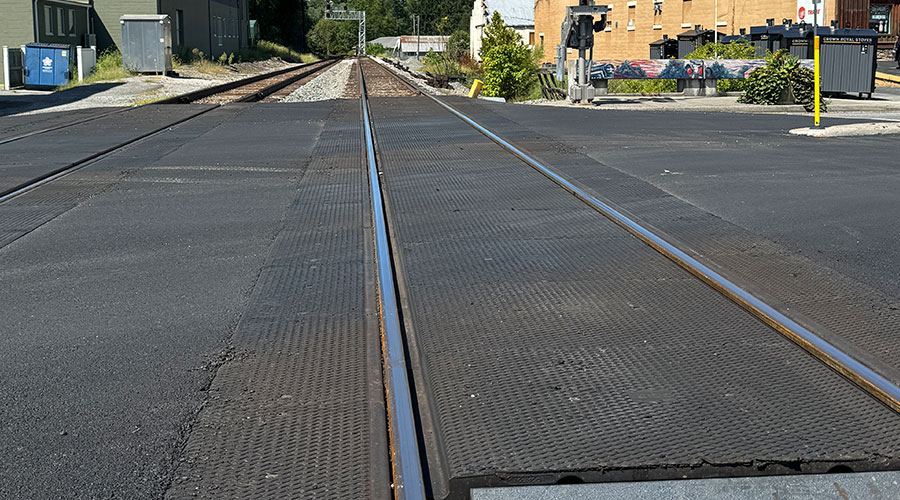Stay updated on news, articles and information for the rail industry
April 2012
Rail News: C&S
Communication and signaling (C&S): Rail yard technology update
by Howard Ande
Moving rail cars and locomotives through yards quickly is critical to reducing dwell times, maintaining transit times, increasing yard efficiency and controlling operating costs. Technology has always played a key role in keeping yards fluid.
What's new on the technology front? How can it help railroads meet their efficiency expectations? What are railroads looking for, as far as new features or enhancements? Last month, we posed those questions via email to several rail yard control technology providers. Edited portions of their responses follow.
Global Rail Systems Inc.
In the past, when freight railroads aimed to automate a yard, it meant putting in a hump so higher productivity could be achieved in the car-switching process. With the work Global Rail Systems Inc. (GRS) has been doing over the past 10 years in hardware and software development with respect to automating flat switching yards, a railroad can achieve hump-like productivity from a flat switching yard, said Coy Beaman, GRS founder and president. That productivity can be achieved with "only 20 percent of the acquisition cost of a hump yard and at a small fraction of the maintenance cost," he added.
"At Global Rail Systems, FYI is not an acronym that means For Your Information — it means Flat Yard Innovation," he said.
Customers that use the company's Modular Yard Automation (MYA) systems are obtaining higher productivity and safer operations, and they're able to track assets throughout the yard with "significantly higher accuracy," Beaman said, adding that the return on investment is less than two years.
"When developing products for MYA, we focused on ensuring their electronics package was designed for the environment we were putting them in," he said, adding that the first design offerings were targeted for freight railroads. "We are now releasing our next-generation of electronics for MYA systems; this set of electronics is focused on transit yard operations."
Regarding the latter: GRS has spent the past two years designing a new set of electronics that are vital and safety critical. "We are now releasing the Universal Vital Platform," Beaman said. "Each yard machine will be able to house its own vital microprocessor, vital detection circuits, and communicate upstream and downstream to adjacent switch machines for vital routing through a yard."
In general, customers want "higher and higher levels of capabilities" from GRS systems, Beaman said; they're asking the company to track cars from the moment they enter a yard until they moment they leave it.
"We are now integrating wayside kiosk, switch control software — YardMaster™ — and Central Office Control software to the railroad's car management system to provide this information automatically," he said.
Meanwhile, GRS's RailMaster software is "extremely flexible and scalable" to allow for any yard application railroads and transit agencies might need, he added.
GRS also has made enhancements to equipment in its catalog. For example, the TS-4500 switch machine is now available in a "close clearance package" that lowers the machine's profile to less than 10 inches, Beaman said. The throw rod technology of the new model, the TS-4500-CC, has been modified to eliminate a potential tripping hazard that exists with other switch machines, he added.
Invensys Rail
When it comes to rail yard control equipment and systems, Invensys Rail officials note that "several customers utilize an entrance and exit switch control and routing automation solution through the use of data radios, and local wayside vital microprocessor modules for track indication and switch control," the company said.
In terms of new products, the company is looking into potential office and other software automation solutions that would provide a seamless operation for train yard dispatcher controls.
What are railroad customers looking for in terms of system features? Wireless solutions that "allow upgrading of the existing systems without the need for cumbersome cable and equipment installation," the company said. In the meantime, Invensys Rail will explore new product solutions as "new opportunities and customer demands are realized," the company said.
RailComm
At RailComm, eliminating bottlenecks through better coordination in yards has been the company's focus.
"The trend is to move from islands of automation (separate disconnected systems) in the various parts of the yard to an integrated yard control and information systems platform," said RailComm President and Chief Executive Officer Joe Denny. "The result is more information sharing between the various systems in the yard, reducing communication errors and the lag time between events. This, in turn, creates more efficient work around classifying cars and building new trains."
In terms of new developments, RailComm has transformed its DOC® Domain Operations Controller system platform from a command-and-control-based platform solution into an information systems-based platform solution, Denny said.
"As the capabilities of our solution increase, such as the addition of car tracking, we can offer decision support planning tools through our RailComm Central platform," he said.
The company also has introduced the RailComm Connect Link device, which provides a secure remote access to the RailComm data center and is part of the maintenance support agreement offering. RailComm also launched the Canadian Rail Operating Rules version of its Dark Territory Control system. What product features are railroads demanding these days? Availability and reliability, Denny said.
"RailComm has worked with our customers to identify and eliminate single points of failure that would affect availability of the yard automation systems," he said. "We have introduced redundancy options for all mission critical components and subsystems."
The company recently simplified its Integrated Automation Controller device, which is used to control any power switch machine on the market, Denny said. The new design increases functional capability and simplifies manufacturing, installation, and maintenance by "significantly reducing the number of components in the assembly," he added.
Siemens Industry Infrastructure and Cities Sector
In the 40 years that Siemens has been active in yard control and operations, technology has migrated from "a manually operated switching facility, over a locally managed, mechanized marshalling yard, to a modern, integrated and somewhat automated hub," said Eckart Thies, director of Siemens Industry Infrastructure and Cities Sector. "While the trend of automation within the yard is unbroken, making the actual classification process faster, more reliable and safer, it is increasingly of significance to the railroads in North America and abroad to tie the management processes within the yards together with the demands from the mainline."
And data integration — data depth, quality and timeliness — are the drivers for continued improvement.
"Data and process integration trumps physical expansion, as the productivity goals are achievable with less capital investment and can be mimicked in other locations rapidly and easily," said Thies.
At Siemens, the yard focus is on "the harmonization and improvement of the process," he said. Although the hump process control is "fairly mature" from performance and reliability standpoints, Siemens officials are "convinced that the aggressive growth targets of their railroad customers are best addressed in areas where process harmonization and optimization can produce immediate, measurable results," Thies said.
To that end, Siemens' projects in high-performance yards have demonstrated how process integration can achieve double-digit performance improvement while reducing operations costs drastically, he added. New developments include operations improvement and planning/scheduling applications, utilization of wireless and cloud technology, as well as supporting features such as precision tracking.
Siemens' customers say they are "predominantly concerned" about three yard-related issues: equipment obsolescence; the economy, which is "challenging them to a steep increase in car count"; and the loss of knowledgeable railroaders from the workforce, Thies said. Several customers have "improved their footprint and offerings to address these issues and departed from the limited hump process control and components business" to what Thies termed as "more IT solution-based applications and services." Accordingly, railroads have started to talk with suppliers about terminal management, he said.
Trainyard Tech L.L.C.
Trainyard Tech L.L.C. customers want more information on the rolling characteristics of rail cars in hump yards, so the company is providing daily reporting on cars with poor rolling traits or "bad rollers," officials said. The information is forwarded to mechanical department personnel who perform additional inspections.
Meanwhile, Trainyard Tech has installed a "first of its kind" system for monitoring car separation at the Indiana Harbor Belt Railroad Co.'s Gibson Yard in Hammond, Ind., company officials said. The system features wheel sensors that monitor the movement of trains being switched from both yard ends. The system also provides separation in the yard dynamically using "very little field hardware" compared with legacy shove light systems, Trainyard Tech execs said.
Also at Gibson Yard: Trainyard Tech currently is installing a new type of shove system — the ShoveMaster — that provides an electronic method of determining the length of train being shoved into each track space in the flat yard.
The system maintains the track spaces used and reserved from both ends of the track, enabling the operator to shove and flat sort from both ends of the yard simultaneously, which "greatly increases the overall productivity of the sorting operation," Trainyard Tech officials said. ShoveMaster sends information to a control yardmaster workstation, displays it over outdoor scoreboards and sends it wirelessly to "wearable" computer devices. The equipment enables transportation ground operators to communicate with the system, reserve track space and upload information directly from the field.
To boost yard productivity, Trainyard Tech offers a new web-based tool called TTReporter. Using any computer with access to a railroad's intranet, and with the proper authorization, a user can point his or her browser to the TTReporter link and pull up reports and car data via a point-and-click style interface. The tool has "significantly improved the time to access information from the process control system and has reduced the number of people traditionally involved in gathering data to satisfy any questions a user might have," Trainyard Tech officials said. So far, TTReporter has been installed in four yards and has "proven to be a huge success," according to the company. Meanwhile, the TYTCarReporter performs similar functions and has cut the time of finding data for a specific car from hours to seconds, Trainyard Tech execs said.
ZTR Control Systems Inc.
The radio remote control (RCL) market demands a solution that provides greater flexibility and usability across a locomotive fleet or for yard service, where the RCL unit isn't captive to a unit and the installation time is less than 30 minutes, according to officials at ZTR Control Systems Inc.
Remote asset monitoring also is on customers' "want" lists, the company said. Railroads are seeking greater operational efficiency, as well as more information on the health and utilization of equipment and locomotives.
To that end, ZTR now offers a Nova portable radio remote control unit with portable speed control that can be installed in less than one hour, is fully transferable and uses "leading radio technology" for greater range.
The company's Nova Touch transmitter incorporates a large touch screen for real-time feedback that can be answered with the touch of a finger. Information and options are "completely customizable," the company said. When feedback plays a lesser role in the application, ZTR's Nova-XL transmitters are available with LCD or LED feedback.
ZTR also offers an array of SmartStart® options, including SAVER™, which provides GPS location and Geofencing, generates fleet reports, exports SmartStart reports, offers automated alarm notifications and incorporates mobile applications such as Near Me™).
On the operational improvement side, ZTR also offers Battery Saver, which can help reduce unnecessary drain on locomotive batteries when shutdown or unattended for long periods, according to company literature.
Howard Ande is a Bartlett, Ill.-based free-lance writer


 LRW Honors Amtrak’s Acheson As Railway Woman Of The Year
LRW Honors Amtrak’s Acheson As Railway Woman Of The Year
 From Editor-In-Chief Foran: Of Gender Equity And Inclusion
From Editor-In-Chief Foran: Of Gender Equity And Inclusion
 Spotlight On Some Of Today’s Rail Safety Products
Spotlight On Some Of Today’s Rail Safety Products
 Women of Influence in Rail eBook
Women of Influence in Rail eBook
 railPrime
railPrime







